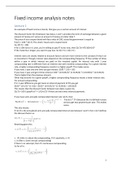Fixed income analysis notes
Lecture 1
An example of fixed income is bonds, that give you a certain amount of interest.
The discount factor Z(t,T) between two dates, t and T, provides the term of exchange between a given
amount of money at t versus an amount of money at a later date T.
The price of zero coupon bond with face value of 100, issued by government is equal to
Pz(t,T) = 100 * Z(t,T). The small z means zero coupon bond.
So, Z(T,T) = 100.
If for a 100 euros in 1 year, you’re willing to pay 97 euros now, then Z(t,T)==97/100=0.97
If the maturity is longer, you want to pay less. So Z(t, T1 ) ≥ Z(t, T2 )
Interest rates are closely related to discount factors and are more similar to the concept of return on
an investment. Though, interest rates depend on the compounding frequency → the number of times
within a year in which interest are paid on the invested capital. An interest rate with 1 year
compounding rate is different from an interest rate with monthly compounding. For a given interest
rate, a higher compounding frequency results in a higher payoff. This makes sense.
If you have 1 year and one time you get interest: $100 * 1.05 = 105
If you have 1 year and get 4 times interest: 100 * (1+0.05/4) * (1+0.05/4) * (1+0.05/4) * (1+0.05/4).
That is higher than the previous amount.
Other way around: for a given payoff, a higher compounding frequency means a lower interest rate.
For annual compounding
If in 1 year difference you get twice an interest payment of 5% you get
$100 * (1+r/2) * (1+r/2) = $100 * (1+0.05/2) * (1+0.05/2) = 105.0625
This means that the discount factor between two dates is given by
Z(t,T) = 100 / payoff at T = 1/(1+r/2)2 if there are two times interest payments
If you have semi-annually compounded interest rate r2(t,T), then
You do 2 * (T-t) because the t is defined in years
and you get two payments per year. This makes
sense.
This also means:
If r2(t,T) is the annualized semi-annually compounded interest rate between t and T, then r2(t,T) defines
the discount factor as:
Rewriting gives this:
rn → Little n is about the compounding. If it’s quarterly, n =4.
rn is often r2 (semi-annual compounding)
if there’s no subscript, then it’s continuous compounding.
So for all n:
1
,The continuously compounded interest rate is obtained by increasing the compounding frequency n
to infinity. lim(1+x/n)n = ex
The continuously compounded interest rate r(t,T) is given by Z(t,T) = e-r(t,T)(T-t)
𝒍𝒏(𝒁(𝒕,𝑻))
You obtain r(t,T) = - 𝑻−𝒕
Rewriting for all n implies:
More frequent compounding implies lower interest rate. Though, the discount factors Z(t,T) is the
same!
The term structure of interest rates is about how interest rates differ by
maturity on a certain moment. So the relation between the level of interest
rates and their time to maturity T-t. Typically, the term structure is upward
sloping. The longer the time to maturity, have higher interest rates. When
the term structure is downward sloping, this is the case when the short
term interest rates are very high.
If the interest rate suddenly increases, then you have a very bad return on
bonds that are already bought.
There’s the principle of no arbitrage condition exists. This implies also law of one price; assets with
same payoff have the same price.
Until now there was zero-coupon bonds.
Consider a bond with coupon rate c, with semi-annual coupon payments and payment dates. Discount
factors Z(t,Tj) for each date Tj. then the value of the coupon bond can be computed as.
You need to divide the coupon by 2, because it’s semi-annual. C is coupon rate, which is a percentage
which you need to multiply by the face value.
This is without multiplying with the FV.
T1 is after half a year. T2 is after 1 year.
An example: a 2 year note issued on January 2006. On that date,
6 month: Z(t,t+0.5) = 0.98
1 year: Z(t,t+1) = 0.96
1.5 year: Z(t,t+1.5) = 0.94
2 year: Z(t,t+2) = 0.91
The payment each half a year = $2.2
Then the price = 2.2 * ∑4𝑖=1 𝑍(𝑡, 𝑡 + 0.5 ∗ 𝑖) + 100 ∗ 0.91
That price = 2.2 * (0.98+0.96+0.94+0.91)+100*0.91
Yield on a zero-coupon bond is the same as the interest rate. For coupon bonds, that’s not the case.
We’ll not really use that in this course.
We can also compute the implicit value of zero coupon bonds. We can observe the prices, and from
that we want to get the discount factors. This is called the bootstrap methodology.
2
,Rewriting gives:
Let t be a given date, with n coupon bonds, witch coupon cj and maturities Tj. let’s assume that
maturities are regular intervals of six months.
The first discount factor Z(t,T1) is given by
𝑃𝑐 ∗(𝑡,𝑇1)
Z(t,T1) = 𝑐 → it has only one cashflow, which is the repayment of FV + the only coupon it pays.
100∗(1+ 1 )
2
Any other discount factor Z(t,Ti for i=2,…n) →
Note the difference between i and j!
You subtract the previous period.
If c2 = r2, then the price is equal to par.
Though, in reality, not all bonds are so liquid and the information might not be available for all
maturities. Also, they’re not issued every day, resulting in information on T=0.4,0.9 etc. in stead of
T=0.5,1,etc.. That’s why we use interpolating of the term structure.
The Nelson-Siegel method solves for this. You observe bond prices, and you make an assumption about
the interest rates. Then, you assume that it has to do with parameters λ and θ’s.
Then, you can calculate the model-implied price of that bond. And you try the least squared difference
between the real price and the model price.
θ0 = long term interest rate (asymptote) → 𝑟(𝑡,∞)=𝜃0
θ1 = slope of the term structure = difference between LT interest rate and short term interest rate.
𝑟 (𝑡,𝑡) =𝜃0 +𝜃1 and hence the slope 𝑟 𝑡,∞ −𝑟 𝑡,𝑡 =−𝜃1
θ2 = it controls the shape of the term structure (upward, downwards, hump, etc.).
λ= how fast it converts to the asymptote. The larger the lambda, the slower the conversion to the
asymptote.
Floating rate bond means that the coupon changes over time.
The rate bond is determined by: c(Ti) = 100 * (r2(Ti-0.5)+s)/2 if it’s semi-annual coupon payments.
The cashflow on T1 is 1+interest rate that was observed today * FV + a spread. So you look today at a
rate and then you determine the coupon in the next period based on what you observe today. You
have half year periods, and each half a year you determine the coupon you’ll pay in 6 months.
Make sure to divide r2 by 2 if it’s semi-annual.
Where r2(t)=r2(t,t+0.5) is the 6 month treasury rate at t which you observe, and s is a spread. Each
coupon date is also called reset date as it is the time when the new coupon is reset.
3
, The spread is a fixed payment on the bond so we can value it separately.
Lecture 2
The duration is the percent sensitivity of its price to a small parallel shift in the level of interest rates.
Dr(t,T) = dr for all T. So we assume that the change in interest rates is the same for all maturities. So
there’s always a parallel shift in interest rates.
Note that you take the right interest rate in case of maturity and compounding.
So it’s the slope of the P(r,t,T).
1 𝑑𝑃(𝑟,𝑡,𝑇)
D = − 𝑃𝑟,𝑡,𝑇) ∗ 𝑑𝑟
For a zero coupon bond with maturity T, we get:
Pz (r,t,T) = 100 * e-4(t,T)*T-t) for continuous compounding
For coupon bonds, the duration is smaller because you have intermediate /earlier payments.
The slope is dP/dr = duration
If interest rights go up, how much does the price fall.
The latter formula is dividing both sides by P, and
then you get the relative change.
If coupon = interest rate, you trade at par. When the
interest starts to increase, the price drops based on
the duration. If the duration is high, the change in
price is big.
Value at risk tells you about the magnitude of losses
that you may suffer in 5% of the cases.
-(μo – 1.645*σp) is just the definition of 95%VaR
4






